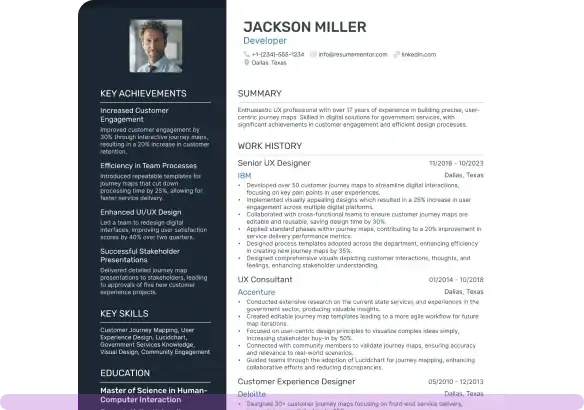HR Manager Resume Examples & Writing Tips for 2025

Jul 18, 2024
|
12 min read
Land your next HR gig by putting your best foot forward.
Rated by 348 people

Workforce Development Manager
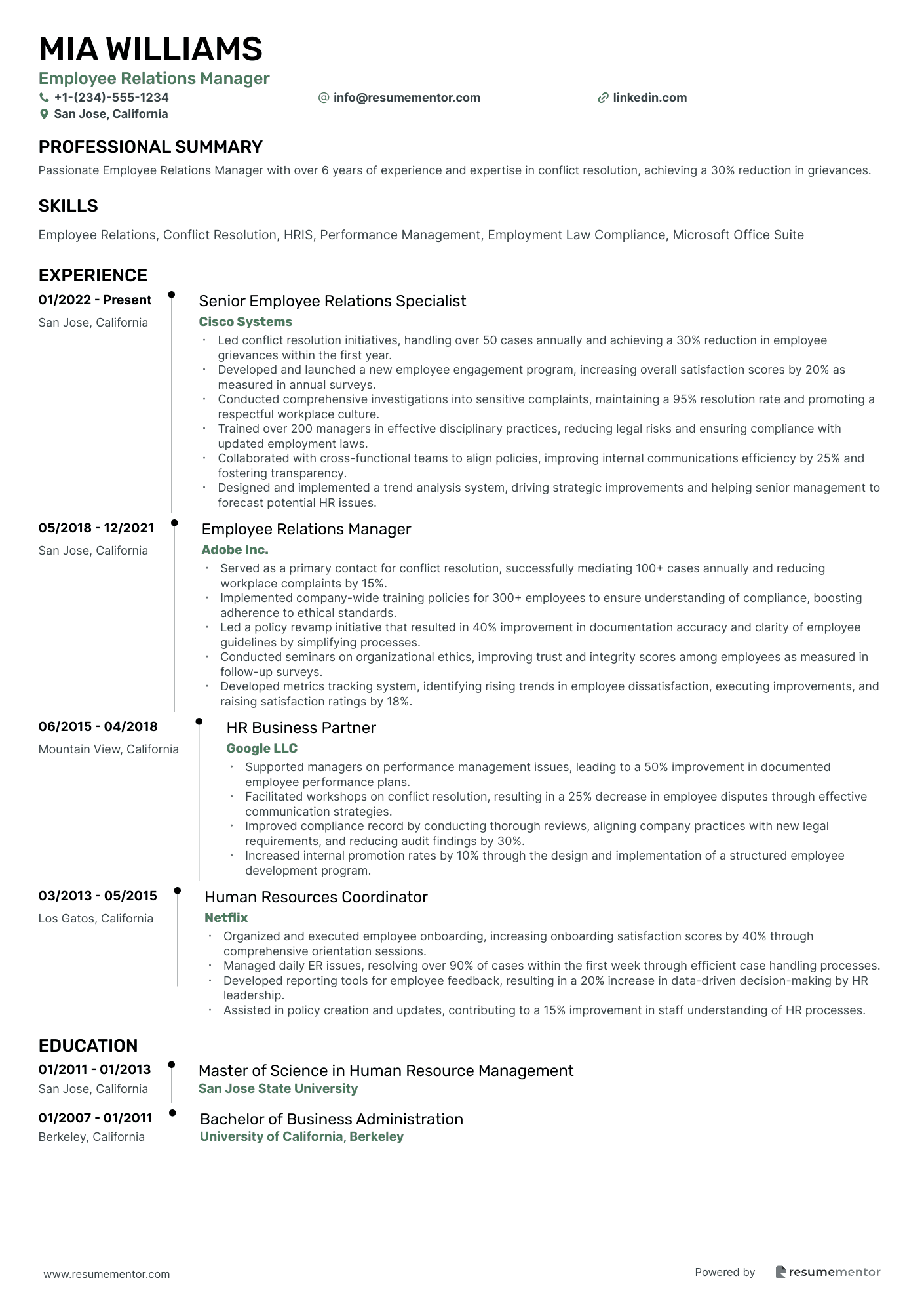
Employee Relations Manager
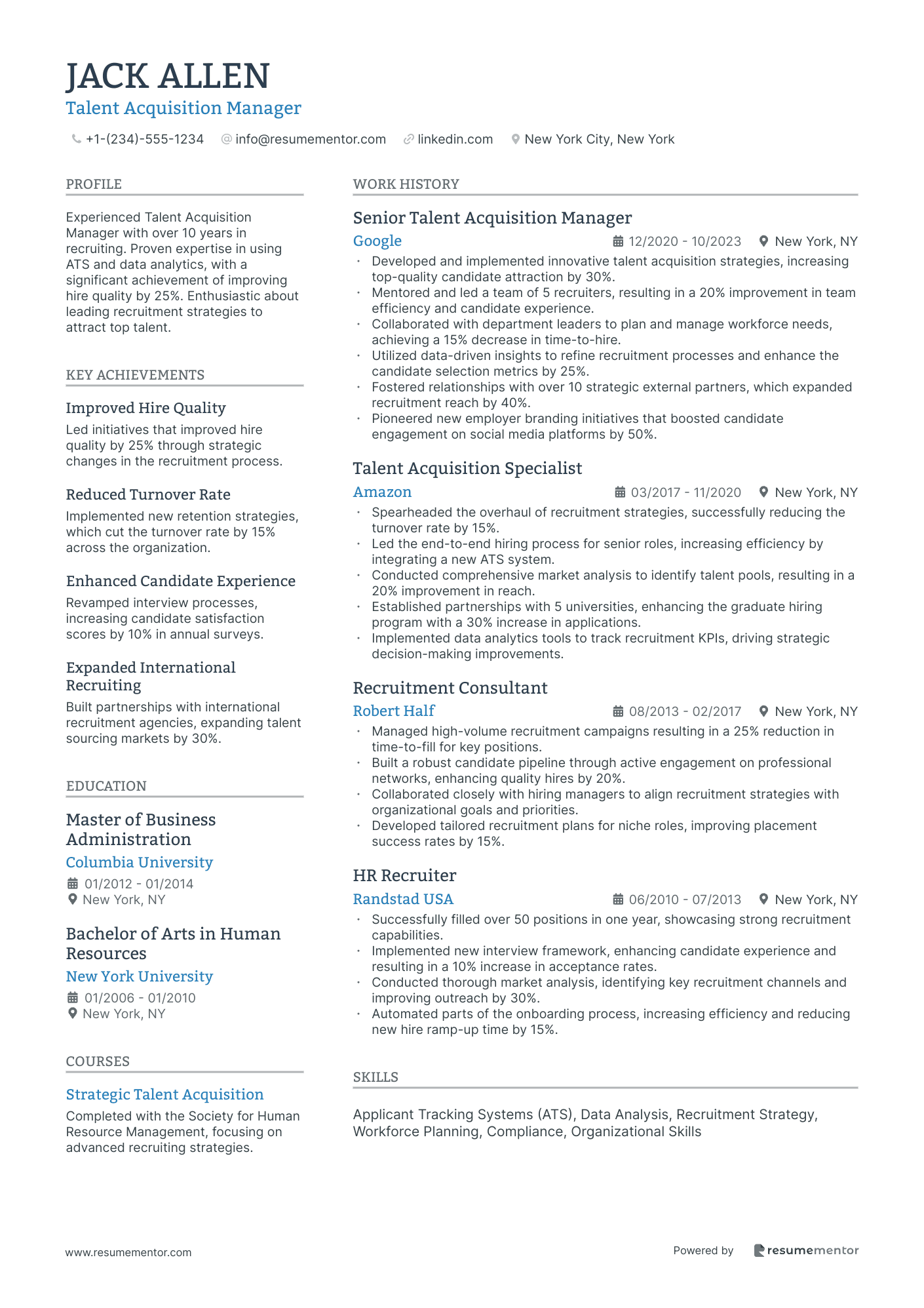
Talent Acquisition Manager
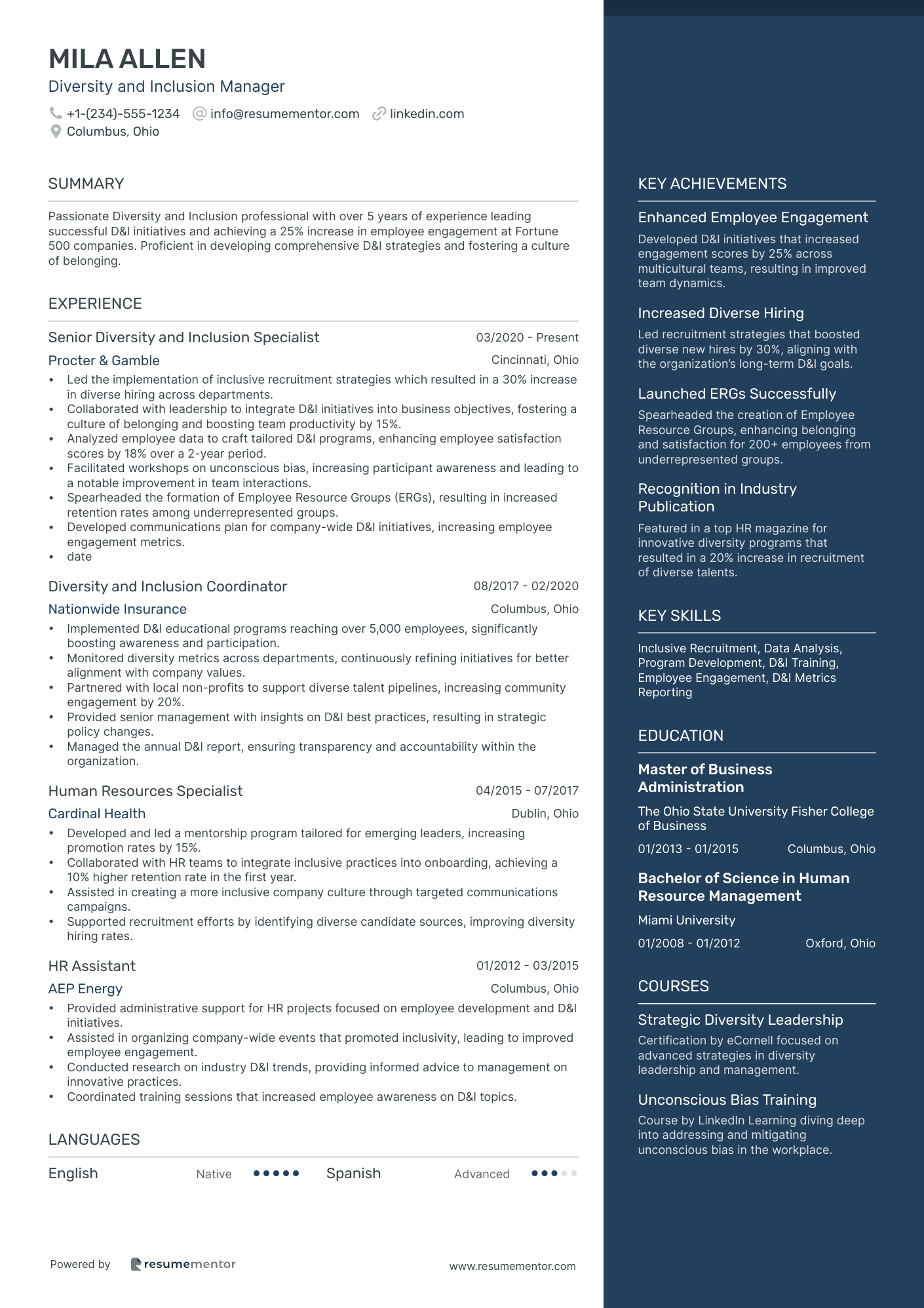
Diversity and Inclusion Manager
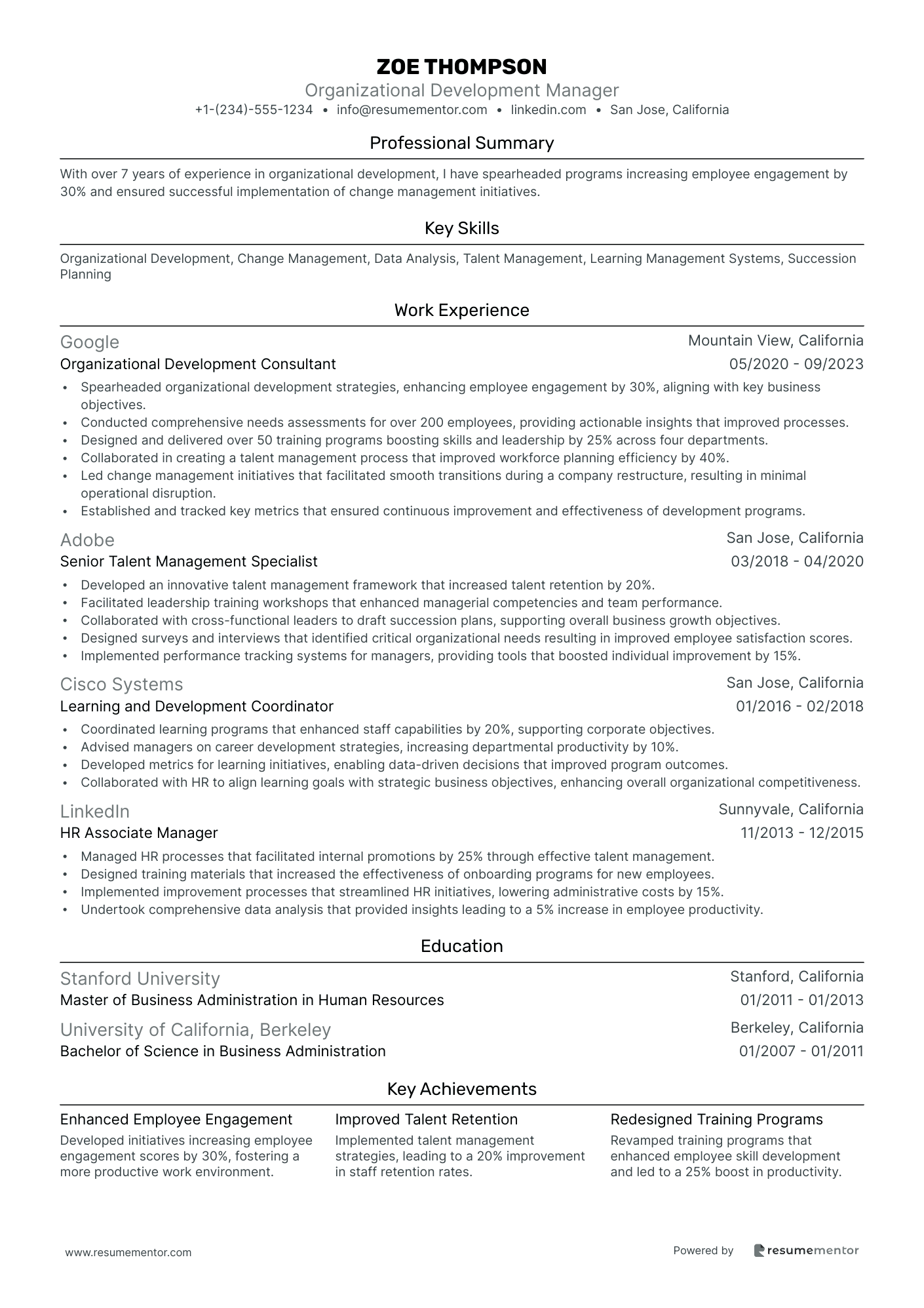
Organizational Development Manager
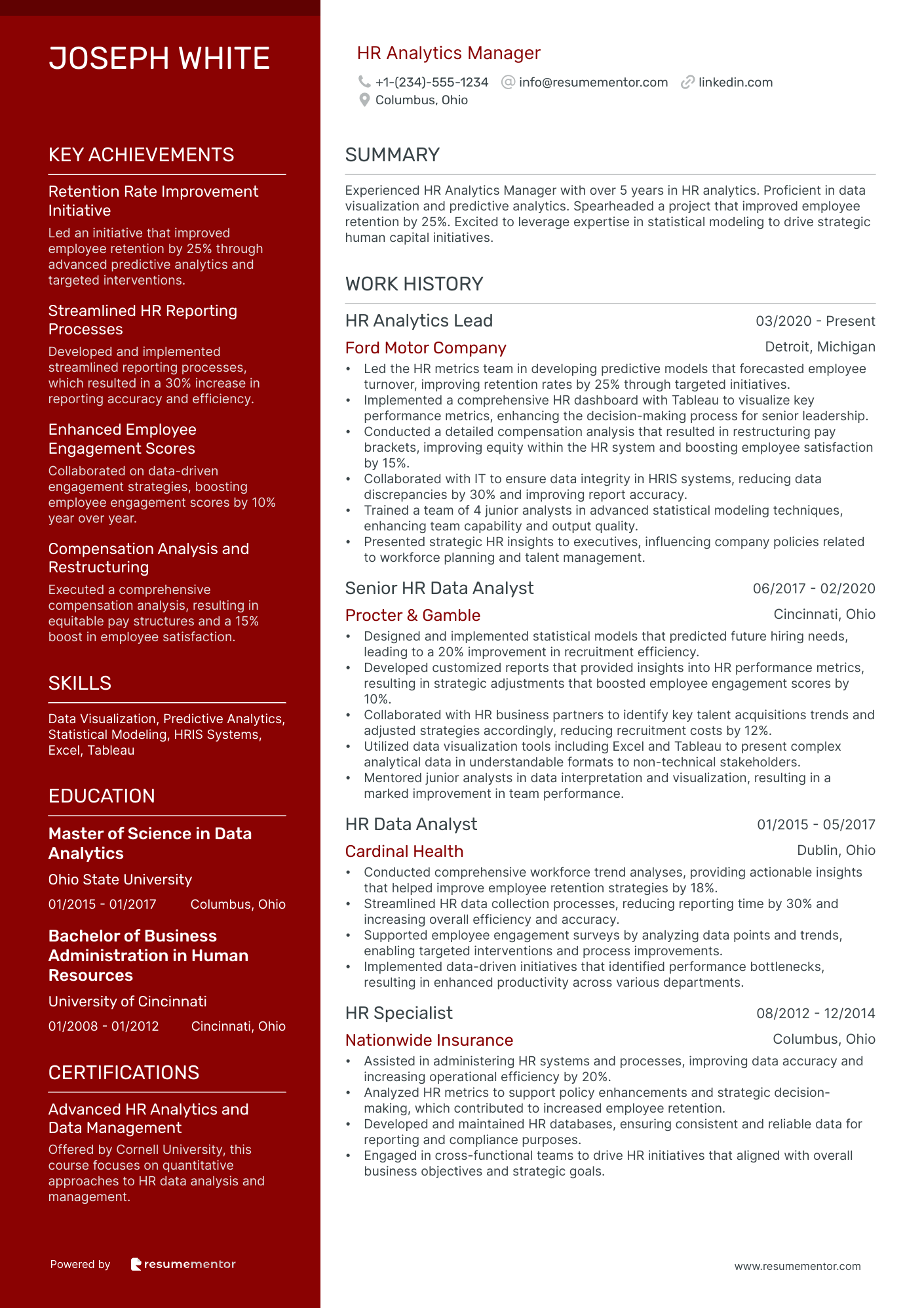
HR Analytics Manager
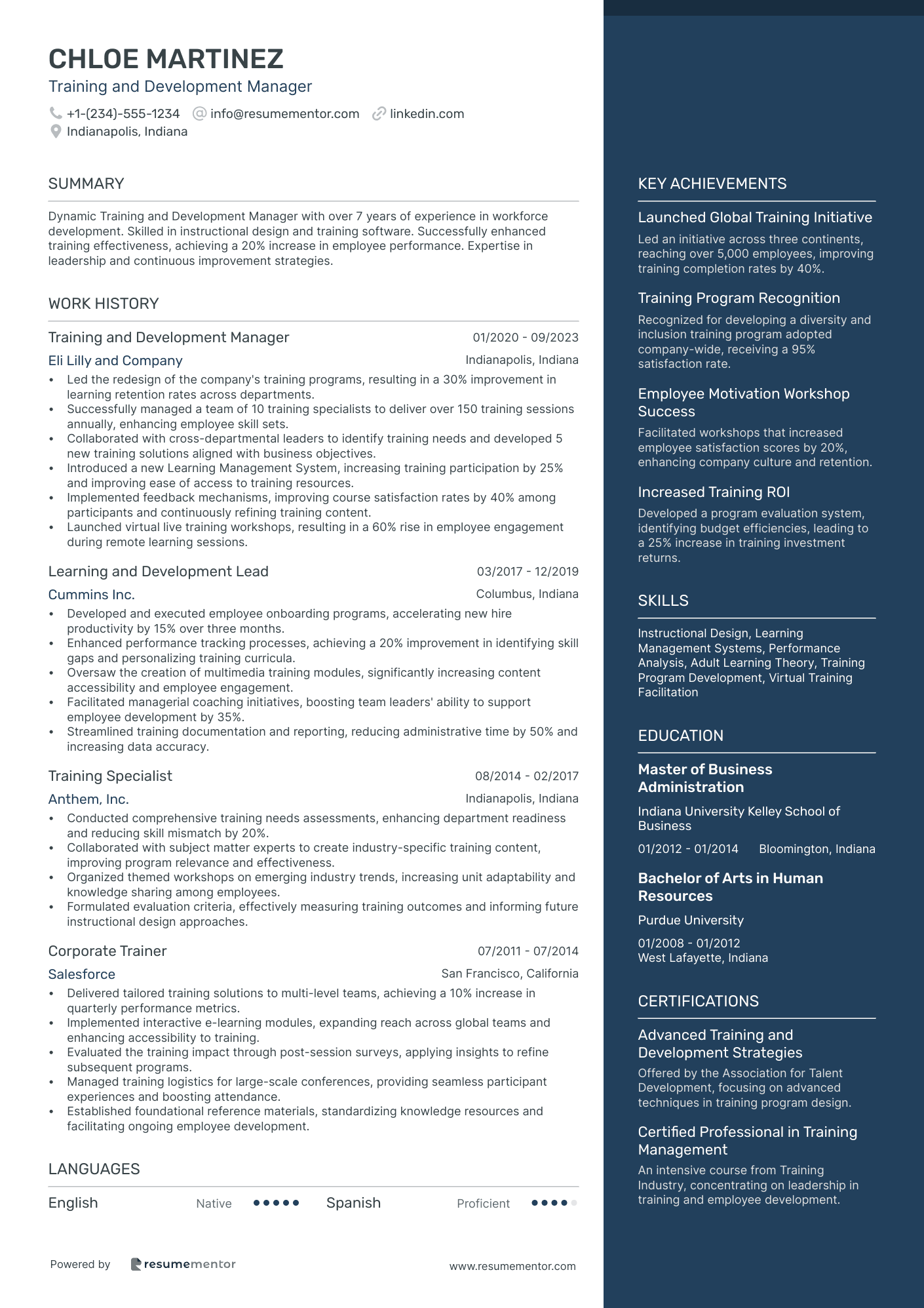
Training and Development Manager
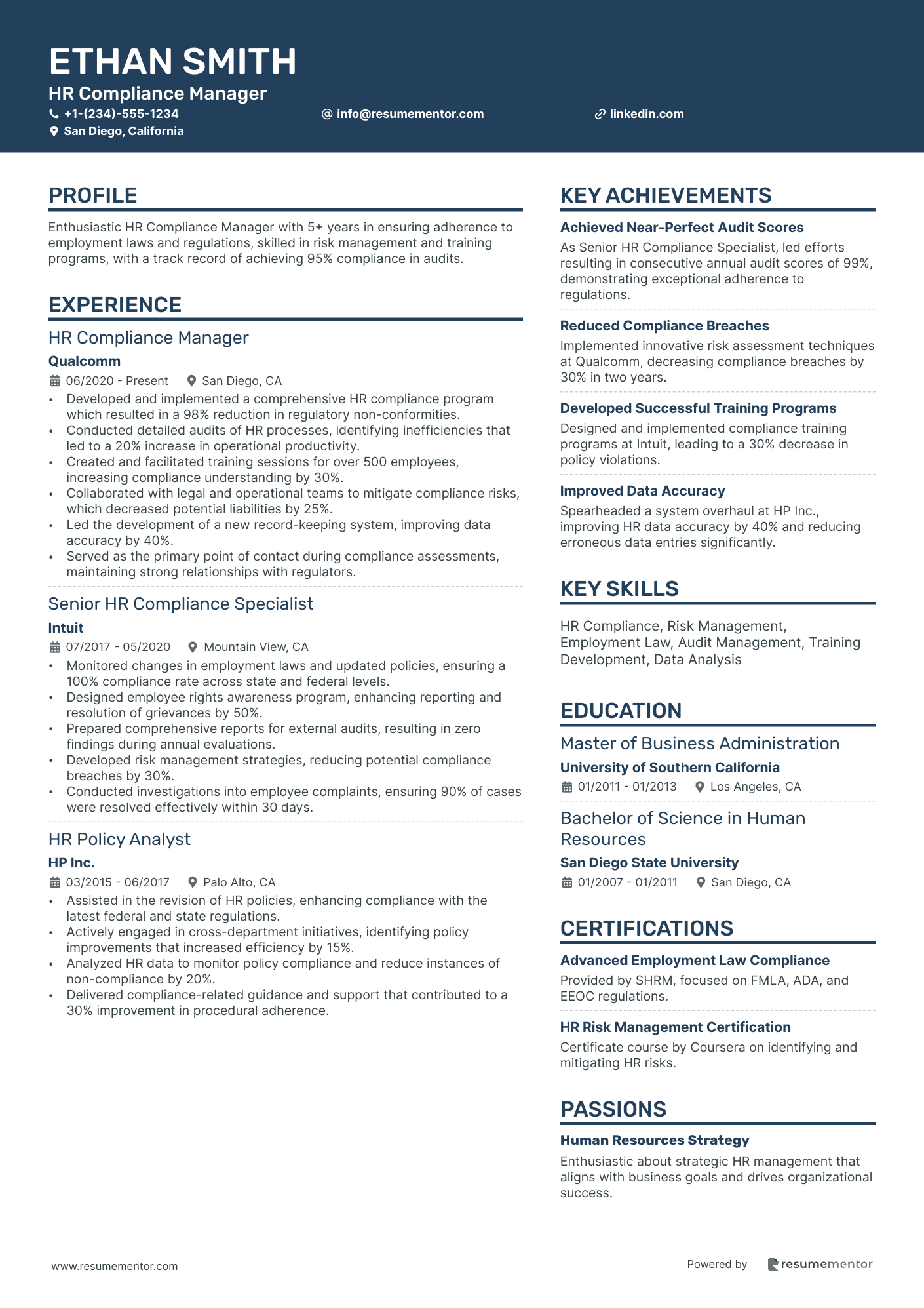
HR Compliance Manager
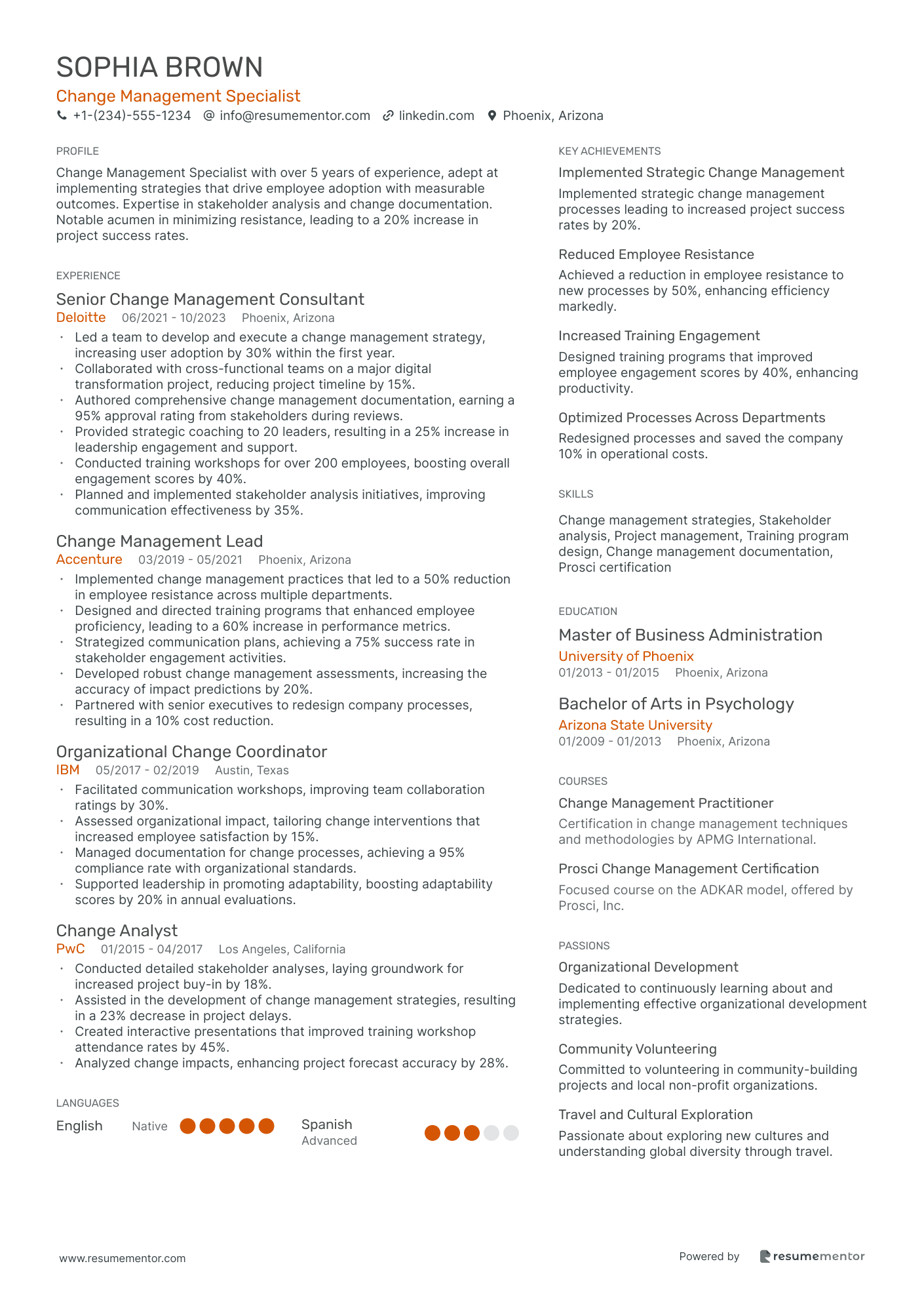
Change Management Specialist
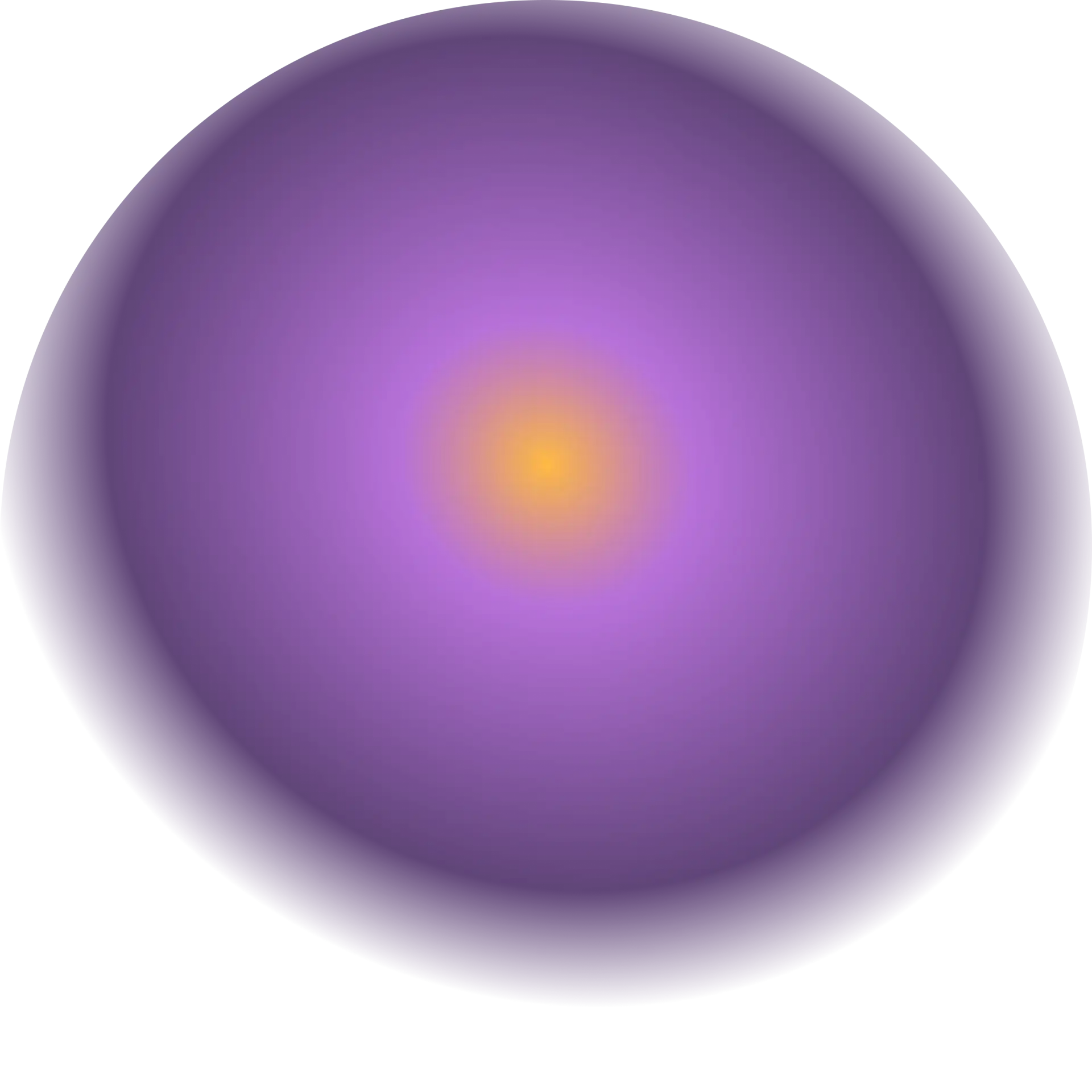
Workforce Development Manager resume sample
- •Successfully designed and implemented a community workforce program, resulting in a 45% increase in participant employment rates within 18 months.
- •Collaborated with over 50 local employers and educational institutions, creating tailored training programs addressing specific industry requirements.
- •Conducted comprehensive labor market research, influencing program direction and improving alignment with current employment trends for better participant outcomes.
- •Facilitated over 100 workshops, enhancing the skill sets of job seekers and increasing their employability significantly.
- •Managed grant application processes, securing over $1.5 million in funding to expand workforce initiatives and provide more resources for the community.
- •Prepared detailed reports and presentations for stakeholders, clearly demonstrating program impact and success through data-driven insights.
- •Led a team that provided career services to over 2000 students annually, improving job placement rates by 28% from previous years.
- •Developed relationships with industries, resulting in new internship and employment opportunities for students across diverse sectors.
- •Executed job fairs and networking events, drawing participation from more than 100 employers, thus broadening exposure for job seekers.
- •Analyzed employment trends and labor statistics to adjust career guidance, ensuring relevance and effectiveness of advisory services.
- •Implemented a new data management system, streamlining operations and providing deeper insights through enhanced metric tracking.
- •Managed vocational training programs, achieving a 32% increase in successful job placements through innovative curriculum redesign.
- •Worked closely with community leaders to identify workforce gaps and launched targeted solutions, driving community-based employment services.
- •Led initiatives to secure local partnerships, enhancing relevance and reach of training offerings for over 500 participants annually.
- •Conducted impactful presentations on program performance and challenges to funding bodies, securing continuous financial support.
- •Designed skill enhancement modules, resulting in a 20% improvement in adult learners' job acquisition rates over 12 months.
- •Partnered with local industries to introduce job-specific training, directly supporting regional economic growth.
- •Monitored and evaluated program success, presenting detailed findings that strengthened board processes and decision-making.
- •Collaborated in a team tasked with modernizing educational materials, increasing participant engagement and retention rates.
Employee Relations Manager resume sample
- •Led conflict resolution initiatives, handling over 50 cases annually and achieving a 30% reduction in employee grievances within the first year.
- •Developed and launched a new employee engagement program, increasing overall satisfaction scores by 20% as measured in annual surveys.
- •Conducted comprehensive investigations into sensitive complaints, maintaining a 95% resolution rate and promoting a respectful workplace culture.
- •Trained over 200 managers in effective disciplinary practices, reducing legal risks and ensuring compliance with updated employment laws.
- •Collaborated with cross-functional teams to align policies, improving internal communications efficiency by 25% and fostering transparency.
- •Designed and implemented a trend analysis system, driving strategic improvements and helping senior management to forecast potential HR issues.
- •Served as a primary contact for conflict resolution, successfully mediating 100+ cases annually and reducing workplace complaints by 15%.
- •Implemented company-wide training policies for 300+ employees to ensure understanding of compliance, boosting adherence to ethical standards.
- •Led a policy revamp initiative that resulted in 40% improvement in documentation accuracy and clarity of employee guidelines by simplifying processes.
- •Conducted seminars on organizational ethics, improving trust and integrity scores among employees as measured in follow-up surveys.
- •Developed metrics tracking system, identifying rising trends in employee dissatisfaction, executing improvements, and raising satisfaction ratings by 18%.
- •Supported managers on performance management issues, leading to a 50% improvement in documented employee performance plans.
- •Facilitated workshops on conflict resolution, resulting in a 25% decrease in employee disputes through effective communication strategies.
- •Improved compliance record by conducting thorough reviews, aligning company practices with new legal requirements, and reducing audit findings by 30%.
- •Increased internal promotion rates by 10% through the design and implementation of a structured employee development program.
- •Organized and executed employee onboarding, increasing onboarding satisfaction scores by 40% through comprehensive orientation sessions.
- •Managed daily ER issues, resolving over 90% of cases within the first week through efficient case handling processes.
- •Developed reporting tools for employee feedback, resulting in a 20% increase in data-driven decision-making by HR leadership.
- •Assisted in policy creation and updates, contributing to a 15% improvement in staff understanding of HR processes.
Talent Acquisition Manager resume sample
- •Developed and implemented innovative talent acquisition strategies, increasing top-quality candidate attraction by 30%.
- •Mentored and led a team of 5 recruiters, resulting in a 20% improvement in team efficiency and candidate experience.
- •Collaborated with department leaders to plan and manage workforce needs, achieving a 15% decrease in time-to-hire.
- •Utilized data-driven insights to refine recruitment processes and enhance the candidate selection metrics by 25%.
- •Fostered relationships with over 10 strategic external partners, which expanded recruitment reach by 40%.
- •Pioneered new employer branding initiatives that boosted candidate engagement on social media platforms by 50%.
- •Spearheaded the overhaul of recruitment strategies, successfully reducing the turnover rate by 15%.
- •Led the end-to-end hiring process for senior roles, increasing efficiency by integrating a new ATS system.
- •Conducted comprehensive market analysis to identify talent pools, resulting in a 20% improvement in reach.
- •Established partnerships with 5 universities, enhancing the graduate hiring program with a 30% increase in applications.
- •Implemented data analytics tools to track recruitment KPIs, driving strategic decision-making improvements.
- •Managed high-volume recruitment campaigns resulting in a 25% reduction in time-to-fill for key positions.
- •Built a robust candidate pipeline through active engagement on professional networks, enhancing quality hires by 20%.
- •Collaborated closely with hiring managers to align recruitment strategies with organizational goals and priorities.
- •Developed tailored recruitment plans for niche roles, improving placement success rates by 15%.
- •Successfully filled over 50 positions in one year, showcasing strong recruitment capabilities.
- •Implemented new interview framework, enhancing candidate experience and resulting in a 10% increase in acceptance rates.
- •Conducted thorough market analysis, identifying key recruitment channels and improving outreach by 30%.
- •Automated parts of the onboarding process, increasing efficiency and reducing new hire ramp-up time by 15%.
Diversity and Inclusion Manager resume sample
- •Led the implementation of inclusive recruitment strategies which resulted in a 30% increase in diverse hiring across departments.
- •Collaborated with leadership to integrate D&I initiatives into business objectives, fostering a culture of belonging and boosting team productivity by 15%.
- •Analyzed employee data to craft tailored D&I programs, enhancing employee satisfaction scores by 18% over a 2-year period.
- •Facilitated workshops on unconscious bias, increasing participant awareness and leading to a notable improvement in team interactions.
- •Spearheaded the formation of Employee Resource Groups (ERGs), resulting in increased retention rates among underrepresented groups.
- •Developed communications plan for company-wide D&I initiatives, increasing employee engagement metrics.
- •date
- •Implemented D&I educational programs reaching over 5,000 employees, significantly boosting awareness and participation.
- •Monitored diversity metrics across departments, continuously refining initiatives for better alignment with company values.
- •Partnered with local non-profits to support diverse talent pipelines, increasing community engagement by 20%.
- •Provided senior management with insights on D&I best practices, resulting in strategic policy changes.
- •Managed the annual D&I report, ensuring transparency and accountability within the organization.
- •Developed and led a mentorship program tailored for emerging leaders, increasing promotion rates by 15%.
- •Collaborated with HR teams to integrate inclusive practices into onboarding, achieving a 10% higher retention rate in the first year.
- •Assisted in creating a more inclusive company culture through targeted communications campaigns.
- •Supported recruitment efforts by identifying diverse candidate sources, improving diversity hiring rates.
- •Provided administrative support for HR projects focused on employee development and D&I initiatives.
- •Assisted in organizing company-wide events that promoted inclusivity, leading to improved employee engagement.
- •Conducted research on industry D&I trends, providing informed advice to management on innovative practices.
- •Coordinated training sessions that increased employee awareness on D&I topics.
Organizational Development Manager resume sample
- •Spearheaded organizational development strategies, enhancing employee engagement by 30%, aligning with key business objectives.
- •Conducted comprehensive needs assessments for over 200 employees, providing actionable insights that improved processes.
- •Designed and delivered over 50 training programs boosting skills and leadership by 25% across four departments.
- •Collaborated in creating a talent management process that improved workforce planning efficiency by 40%.
- •Led change management initiatives that facilitated smooth transitions during a company restructure, resulting in minimal operational disruption.
- •Established and tracked key metrics that ensured continuous improvement and effectiveness of development programs.
- •Developed an innovative talent management framework that increased talent retention by 20%.
- •Facilitated leadership training workshops that enhanced managerial competencies and team performance.
- •Collaborated with cross-functional leaders to draft succession plans, supporting overall business growth objectives.
- •Designed surveys and interviews that identified critical organizational needs resulting in improved employee satisfaction scores.
- •Implemented performance tracking systems for managers, providing tools that boosted individual improvement by 15%.
- •Coordinated learning programs that enhanced staff capabilities by 20%, supporting corporate objectives.
- •Advised managers on career development strategies, increasing departmental productivity by 10%.
- •Developed metrics for learning initiatives, enabling data-driven decisions that improved program outcomes.
- •Collaborated with HR to align learning goals with strategic business objectives, enhancing overall organizational competitiveness.
- •Managed HR processes that facilitated internal promotions by 25% through effective talent management.
- •Designed training materials that increased the effectiveness of onboarding programs for new employees.
- •Implemented improvement processes that streamlined HR initiatives, lowering administrative costs by 15%.
- •Undertook comprehensive data analysis that provided insights leading to a 5% increase in employee productivity.
HR Analytics Manager resume sample
- •Led the HR metrics team in developing predictive models that forecasted employee turnover, improving retention rates by 25% through targeted initiatives.
- •Implemented a comprehensive HR dashboard with Tableau to visualize key performance metrics, enhancing the decision-making process for senior leadership.
- •Conducted a detailed compensation analysis that resulted in restructuring pay brackets, improving equity within the HR system and boosting employee satisfaction by 15%.
- •Collaborated with IT to ensure data integrity in HRIS systems, reducing data discrepancies by 30% and improving report accuracy.
- •Trained a team of 4 junior analysts in advanced statistical modeling techniques, enhancing team capability and output quality.
- •Presented strategic HR insights to executives, influencing company policies related to workforce planning and talent management.
- •Designed and implemented statistical models that predicted future hiring needs, leading to a 20% improvement in recruitment efficiency.
- •Developed customized reports that provided insights into HR performance metrics, resulting in strategic adjustments that boosted employee engagement scores by 10%.
- •Collaborated with HR business partners to identify key talent acquisitions trends and adjusted strategies accordingly, reducing recruitment costs by 12%.
- •Utilized data visualization tools including Excel and Tableau to present complex analytical data in understandable formats to non-technical stakeholders.
- •Mentored junior analysts in data interpretation and visualization, resulting in a marked improvement in team performance.
- •Conducted comprehensive workforce trend analyses, providing actionable insights that helped improve employee retention strategies by 18%.
- •Streamlined HR data collection processes, reducing reporting time by 30% and increasing overall efficiency and accuracy.
- •Supported employee engagement surveys by analyzing data points and trends, enabling targeted interventions and process improvements.
- •Implemented data-driven initiatives that identified performance bottlenecks, resulting in enhanced productivity across various departments.
- •Assisted in administering HR systems and processes, improving data accuracy and increasing operational efficiency by 20%.
- •Analyzed HR metrics to support policy enhancements and strategic decision-making, which contributed to increased employee retention.
- •Developed and maintained HR databases, ensuring consistent and reliable data for reporting and compliance purposes.
- •Engaged in cross-functional teams to drive HR initiatives that aligned with overall business objectives and strategic goals.
Training and Development Manager resume sample
- •Led the redesign of the company's training programs, resulting in a 30% improvement in learning retention rates across departments.
- •Successfully managed a team of 10 training specialists to deliver over 150 training sessions annually, enhancing employee skill sets.
- •Collaborated with cross-departmental leaders to identify training needs and developed 5 new training solutions aligned with business objectives.
- •Introduced a new Learning Management System, increasing training participation by 25% and improving ease of access to training resources.
- •Implemented feedback mechanisms, improving course satisfaction rates by 40% among participants and continuously refining training content.
- •Launched virtual live training workshops, resulting in a 60% rise in employee engagement during remote learning sessions.
- •Developed and executed employee onboarding programs, accelerating new hire productivity by 15% over three months.
- •Enhanced performance tracking processes, achieving a 20% improvement in identifying skill gaps and personalizing training curricula.
- •Oversaw the creation of multimedia training modules, significantly increasing content accessibility and employee engagement.
- •Facilitated managerial coaching initiatives, boosting team leaders' ability to support employee development by 35%.
- •Streamlined training documentation and reporting, reducing administrative time by 50% and increasing data accuracy.
- •Conducted comprehensive training needs assessments, enhancing department readiness and reducing skill mismatch by 20%.
- •Collaborated with subject matter experts to create industry-specific training content, improving program relevance and effectiveness.
- •Organized themed workshops on emerging industry trends, increasing unit adaptability and knowledge sharing among employees.
- •Formulated evaluation criteria, effectively measuring training outcomes and informing future instructional design approaches.
- •Delivered tailored training solutions to multi-level teams, achieving a 10% increase in quarterly performance metrics.
- •Implemented interactive e-learning modules, expanding reach across global teams and enhancing accessibility to training.
- •Evaluated the training impact through post-session surveys, applying insights to refine subsequent programs.
- •Managed training logistics for large-scale conferences, providing seamless participant experiences and boosting attendance.
- •Established foundational reference materials, standardizing knowledge resources and facilitating ongoing employee development.
HR Compliance Manager resume sample
- •Developed and implemented a comprehensive HR compliance program which resulted in a 98% reduction in regulatory non-conformities.
- •Conducted detailed audits of HR processes, identifying inefficiencies that led to a 20% increase in operational productivity.
- •Created and facilitated training sessions for over 500 employees, increasing compliance understanding by 30%.
- •Collaborated with legal and operational teams to mitigate compliance risks, which decreased potential liabilities by 25%.
- •Led the development of a new record-keeping system, improving data accuracy by 40%.
- •Served as the primary point of contact during compliance assessments, maintaining strong relationships with regulators.
- •Monitored changes in employment laws and updated policies, ensuring a 100% compliance rate across state and federal levels.
- •Designed employee rights awareness program, enhancing reporting and resolution of grievances by 50%.
- •Prepared comprehensive reports for external audits, resulting in zero findings during annual evaluations.
- •Developed risk management strategies, reducing potential compliance breaches by 30%.
- •Conducted investigations into employee complaints, ensuring 90% of cases were resolved effectively within 30 days.
- •Assisted in the revision of HR policies, enhancing compliance with the latest federal and state regulations.
- •Actively engaged in cross-department initiatives, identifying policy improvements that increased efficiency by 15%.
- •Analyzed HR data to monitor policy compliance and reduce instances of non-compliance by 20%.
- •Delivered compliance-related guidance and support that contributed to a 30% improvement in procedural adherence.
- •Collaborated with HR teams to identify compliance gaps, resulting in a 25% increase in policy adherence.
- •Maintained detailed records of compliance activities, aiding in reducing response times for regulatory inquiries by 50%.
- •Conducted frequent analysis of HR policies, contributing to a reassessment of practices that improved compliance rates by 15%.
- •Assisted in delivering training programs, enhancing overall knowledge and compliance by 10%.
Change Management Specialist resume sample
- •Led a team to develop and execute a change management strategy, increasing user adoption by 30% within the first year.
- •Collaborated with cross-functional teams on a major digital transformation project, reducing project timeline by 15%.
- •Authored comprehensive change management documentation, earning a 95% approval rating from stakeholders during reviews.
- •Provided strategic coaching to 20 leaders, resulting in a 25% increase in leadership engagement and support.
- •Conducted training workshops for over 200 employees, boosting overall engagement scores by 40%.
- •Planned and implemented stakeholder analysis initiatives, improving communication effectiveness by 35%.
- •Implemented change management practices that led to a 50% reduction in employee resistance across multiple departments.
- •Designed and directed training programs that enhanced employee proficiency, leading to a 60% increase in performance metrics.
- •Strategized communication plans, achieving a 75% success rate in stakeholder engagement activities.
- •Developed robust change management assessments, increasing the accuracy of impact predictions by 20%.
- •Partnered with senior executives to redesign company processes, resulting in a 10% cost reduction.
- •Facilitated communication workshops, improving team collaboration ratings by 30%.
- •Assessed organizational impact, tailoring change interventions that increased employee satisfaction by 15%.
- •Managed documentation for change processes, achieving a 95% compliance rate with organizational standards.
- •Supported leadership in promoting adaptability, boosting adaptability scores by 20% in annual evaluations.
- •Conducted detailed stakeholder analyses, laying groundwork for increased project buy-in by 18%.
- •Assisted in the development of change management strategies, resulting in a 23% decrease in project delays.
- •Created interactive presentations that improved training workshop attendance rates by 45%.
- •Analyzed change impacts, enhancing project forecast accuracy by 28%.
As an HR manager, you wear many different hats. One day, you’re dealing with conflict resolution in the workplace. The next day, you’re onboarding new staff members and making sure you follow all the regulatory processes to a tee.
You know what it means to juggle wide-ranging responsibilities, from admin support and staff supervision to budget and facilities management. But how can you showcase your endless talents on your HR resume?
It’s all about getting the balance right. Not only do you want to emphasize your skills, but you also need to show you have the character for the job. Since HR is all about working with people, you’ll need to have oodles of interpersonal skills, too.
Feeling overwhelmed? You're not alone.
In this guide, we’ll go through essential steps to write an HR manager resume that stands out and helps you land your next big opportunity. Let’s get started.
Key takeaways
- Showcase your proficiency with HR software such as Workday, QuickBooks Payroll, and BambooHR to highlight your technical expertise.
- Quantify your HR-related achievements to demonstrate the impact of your contributions, such as improving employee retention or streamlining onboarding processes.
- Include key HR certifications, like SPHR or CHRP, to establish your qualifications and commitment to the field.
- Use a reverse-chronological resume format to emphasize your most recent and relevant HR experience, aligning with recruiter expectations.
- Underline HR initiatives such as cost-saving strategies, diversity and inclusion programs, or employee engagement improvements to emphasize your strategic contributions.
How to use this HR manager resume guide
Ready to dive in? We’ve designed this guide to help you craft a unique HR resume that highlights your unique skills and career goals. For a more streamlined experience, consider using our resume builder to achieve a polished, professional finish.
Read our expert-backed advice below:
Looking to make the most out of our HR manager resume guide?
There’s a strategy for that. Here’s what you should remember as you’re reading our in-depth guide:
Start with the introduction
Our introduction outlines common challenges faced in HR and explains how this guide will help you address them. Don’t skip over it! This is the perfect starting point to focus your efforts and prepare for the journey ahead.
Review the key takeaways
The key takeaways section summarizes the most important lessons in the guide. Before you start, skim through it to get a sense of the upcoming sections and understand how the guide will benefit you in your resume-building process.
Follow the section-by-section layout
Each section of the guide addresses a specific part of your HR manager resume—from the header and experience to skills and education. Either follow the guide in order or simply jump to sections most relevant to your needs.
Learn from real-world examples
Throughout the guide, you’ll find examples and templates specifically tailored to HR. Whether it’s managing inter-workplace conflict or dealing with staff sickness, add color to your resume.
Check out our tips and highlights
Look out for “Pro Tips” and highlighted resources throughout the guide. Our expert tips offer valuable insights. For example, we’ll cover how to craft impactful bullet points. We’ll also look at securing relevant HR certifications—such as SHRM-CP and PHR—to help you strengthen your resume.
Tailor your resume for maximum impact
No two HR roles are the same. Customize your resume for specific HR roles. Our resume builder can assist you in showcasing your one-of-a-kind HR skills, achievements, and potential impact.
Refer to trusted resources
Make use of recommended tools and platforms, such as LinkedIn Learning, Workday, and BambooHR, to further enhance your resume and demonstrate your expertise.
Apply what you learn incrementally
Resume writing can feel like a big task, but with this guide—and our builder—it’s manageable. Work through one section at a time, applying the advice step by step to create a well-rounded resume.
Save and update
Bookmark this guide and use our resume builder to save your progress. You’ll be able to revisit and update your resume as your career evolves and you gain new experience.
With this guide and our resume builder, you have everything you need to create a resume that sets you apart as an HR professional. Ready to begin? Dive into the first section and take the next step toward your dream job!
Is your resume good enough?
Drop your resume here or choose a file.
PDF & DOCX only. Max 2MB file size.
What to focus on when writing your HR manager resume
Think of your resume as a book. Your HR manager application tells the story of your leadership and career so far. It needs to show how you’ve built strong teams, resolved pesky workplace challenges, and truly shaped the company culture.
PRO TIP
Don’t simply share anecdotes—back them up with cold, hard facts. Use real results and solid metrics to demonstrate your impact on the company. Be clear about how you’ve made your mark, whether it’s boosting retention or driving company-wide improvements.
Before you start writing, you’ll want to pick some central focuses. We recommend highlighting the accounting systems and software you can use, key achievements such as cost-saving initiatives, and relevant certifications and advanced degrees.
Let’s take a look at the main angles you want to take here:
Specific accounting systems and software
HR managers don’t do everything by pen and paper. You need to use a selection of all-singing, all-dancing systems and software. Name-check these on your HR manager resume.
Let’s take a look at some of the tools you may already use:
Don’t assume the recruiter knows you’re fluent in these systems. It’s important to spell everything out for them—and make it clear. That way, there’s no room for confusion.
PRO TIP
Illustrate how you’ve used each piece of software. While you can list them in your skills section, you may also want to add them to your work experience section. You can give them context by writing clear bullet points detailing how you used them to succeed.
Here’s an example:
“Optimized HR operations using BambooHR, streamlining employee onboarding, performance management, and time-off tracking, resulting in a 25% reduction in administrative workload and improved employee satisfaction.”
Key HR-centric achievements
What impact have you made on the business? Throwing in some key achievements on your resume is always the way to go. When adding these accomplishments, always think about the bottom line. What outcome did your efforts have and—importantly—can you quantify that?
PRO TIP
The last thing you want to do is be vague when writing about your workplace accomplishments. Think about the areas where your work had a tangible result.
Here are some examples you may want to consider:
- Talent acquisition and retention
- Employee engagement and company culture
- Cost-saving initiatives (with statistics)
- Training and development program successes
- Compliance and risk management
Relevant certificates and advanced degrees
We’ll cover what exactly to put in your education section later. However, for now, it’s worth noting that boasting the right certification can set you apart from the crowd.
If you’ve taken the time to develop yourself and your skills, shout about it on your resume. Be clear about the courses you’ve taken and the professional certificates you hold as a result.
Include certificates
What type of certificates should you include? The exact courses you take depend on your career aspirations and your HR niche.
However, here are some examples to consider:
Easy-to-read layout and design
Getting the content of your HR manager resume right is one thing. But you shouldn’t ignore the power of your resume layout. You need to make sure your resume is easy to read.
Of course, there are a few ways you can do this. We recommend making use of white space, including bullet points where possible, and using a clear, skimmable design.
Now that you know what to focus on, let’s move on to how to choose the resume format:
How to choose the right resume format
Choosing the best resume format matters more than you might think.
There are three main choices when you’re deciding on the layout:
- Reverse-chronological format: a linear timeline of your career
- Functional format: a skills-based resume layout
- Combination format: a mixture of the two above formats
If your career path is straightforward, use a reverse-chronological resume—list your most recent achievements first and work backward. This is the format recruiters expect to see.
Of course, if you’ve switched careers recently or taken a sabbatical, this approach may not suit you. In that case, you can opt for either the functional (skill-based) or the combination format.
What's the right resume format?
Resume formats aren't one-size-fits-all.
However, in most cases, we recommend the reverse-chronological format for HR managers.
Can I include color on my HR resume?
Yes! There’s nothing wrong with a splash of color on your resume.
However, you don’t want to go overboard. Choose a creative resume template that shows off your professionalism.
How should you save your resume file?
Save your resume as a PDF instead of a Word document—it looks more professional and keeps the formatting intact.
How large should your resume margins be?
Ideally, your resume margins should be between 0.5 to 1 inch.
How do I make a resume that looks professional?
You don’t have to be a design whiz kid to make your own resume.
Use our drag-and-drop resume builder to effortlessly design a pro-level application.
You should be confident in how to format your resume now. Let’s move on to the header first.
What to include in your resume header
Resume headers share your basic details with the recruiter. Think of this section like a business card—delivering your name, contact details, and any links you want to share.
Let’s take a look at what you need:
- Your name: Start with your first and last name.
- Job title: Include the job title that matches the posting, i.e. “HR manager”.
- Contact details: Next, list your professional email and phone number.
- Location: Write down your location, e.g. your city and state.
- Extra links: Link to your LinkedIn page, for example.
Here’s an example of how that would look:
How to write a resume summary
The first step toward success is introducing yourself to the recruiter. You can do that in your resume summary. This short paragraph sits neatly at the top of the page. It’s your chance to make your case to the reader and emphasize why you’re the right fit for the role.
Your words need to pack a real punch. Use powerful resume action words in this section to hook the reader’s attention. Examples include presented, led, organized, and managed.
If you have a case of writer’s block, don’t panic. It happens to the best of us.
Here are some things you should display in your HR manager summary:
- Your years of experience and the industry you work in.
- Your HR niche, e.g. talent acquisition.
- Tangible metrics relating to your achievements.
- Any special awards or training you have.
Always look back at the job announcement first and find examples of what the recruiter is looking for here. It’s savvy to align your summary with their demands.
Not only does the above summary put metrics front and center, it also adds specific details. Sharing the training and awards the candidate has is a quick way to grab some attention.
How to write a quantifiable resume experience section
Next up, it’s time to put some work experience on your resume. Recruiters will expect you to have a proven track record of success—don’t let them down. Once again, you use the reverse-chronological order when listing the positions you’ve previously held.
When it comes to how far back to go on your resume, avoid going back more than 10-15 years. Any experience you have that predates this time frame isn't relevant. What’s more, you could open yourself up to other problems, such as accidental age discrimination.
Include the basics: the company name, location, your role, and your dates of employment. Below that, you can use bullet points to highlight your accomplishments in the role.
PRO TIP
Don’t make the mistake of listing your tasks. Instead, focus on your achievements.
So, rather than talking about what you did in a role, talk about the results you gained—with statistics to back you up. After all, this is what the recruiter really wants to know.
Here’s an example:
- •Reduced employee turnover by 30% by implementing a structured career development program and mentorship initiatives.
- •Optimized hiring processes, cutting time-to-hire by 25% through ATS enhancements and targeted recruitment strategies.
- •Implemented BambooHR, reducing administrative workload by 40% and improving compliance tracking.
- •Launched a company-wide diversity and inclusion initiative, increasing diverse hires by 20% within one year.
- •Developed and executed an employee engagement strategy, improving workplace satisfaction scores by 35%.
- •Led a talent retention initiative that decreased voluntary turnover by 25% over two years.
- •Implemented a leadership training program, resulting in a 40% increase in internal promotions.
- •Oversaw HRIS transition to Workday, streamlining HR processes and improving data accuracy.
- •Developed a conflict resolution framework, reducing workplace disputes by 30%.
- •Introduced an employee recognition program, boosting engagement survey scores by 20%.
Pinpointing systems and software while adding tangible statistics is the way to go. The above work experience section tells a compelling career story.
HR manager resume work experience samples
When crafting the perfect work experience section, you need to play to your professional strengths. What's it that makes you unique? By positioning yourself as a leader in that area, you can pique the reader’s interest.
Let’s take a look at three approaches:
People management focused
HR is all about people—but you know that already. If your superpower is that you’re great with staff, tell the recruiter all about it. Weave this through your work experience section.
- •Managed and coached a team of 12 HR professionals, fostering their career growth and increasing team efficiency by 30%.
- •Implemented a new performance review system that improved manager-employee feedback and increased productivity by 20%.
- •Developed a leadership training program that resulted in a 40% increase in internal promotions to management roles.
- •Created and launched a company-wide mentorship program, enhancing leadership pipelines and employee retention rates.
- •Designed an employee engagement strategy that improved team collaboration and boosted overall satisfaction scores by 35%.
- •Provided coaching and support to over 100 managers, enhancing leadership effectiveness and team performance.
- •Designed and executed a new succession planning framework, ensuring a strong leadership pipeline across all departments.
- •Developed and rolled out a conflict resolution training program, reducing workplace disputes by 30%.
- •Led company-wide change management initiatives, improving employee buy-in and reducing resistance to organizational changes.
- •Facilitated company culture workshops that increased manager-employee trust and improved workplace collaboration.
Optimization focused
Productivity isn't a trend—it’s an essential part of any workplace. If you have what it takes to boost staff productivity, now’s the time to share your secrets.
- •Redesigned HR workflows, reducing administrative burdens and cutting HR processing time by 40%.
- •Automated onboarding and training programs, accelerating new hire productivity by 30% within the first 90 days.
- •Implemented data-driven performance management systems, increasing employee output by 25%.
- •Led an HR tech transformation, integrating Workday and BambooHR, reducing manual HR tasks by 50%.
- •Developed workforce planning strategies that optimized staffing levels, reducing overtime costs by 20%.
- •Optimized recruitment pipelines, reducing time-to-fill positions by 35% and ensuring top talent acquisition.
- •Revamped compensation and benefits structures, increasing employee satisfaction and reducing attrition by 20%.
- •Implemented HR analytics tools to track workforce performance, leading to a 15% increase in productivity.
- •Introduced a company-wide feedback system that improved employee-manager communication and boosted efficiency.
- •Developed automated HR reporting dashboards, cutting manual reporting time by 50% and enhancing decision-making speed.
Staff retention focused
Replacing employees is expensive—costing them about 21% of their annual salary. If you're great at staff retention, that's a big advantage. Highlight this skill in your work experience section.
- •Reduced employee turnover by 35% by launching a structured career development program and mentorship initiative.
- •Implemented a data-driven retention strategy that identified key turnover risks, improving employee retention rates by 25%.
- •Designed and introduced an enhanced employee benefits package, increasing retention among high-performing staff by 20%.
- •Developed a flexible work policy that improved employee satisfaction and led to a 15% decrease in voluntary departures.
- •Established a recognition and rewards program that boosted employee morale and increased long-term retention.
- •Developed and executed an employee engagement program that increased retention rates by 30% over two years.
- •Introduced an exit interview process to analyze turnover trends, leading to targeted interventions that reduced attrition by 25%.
- •Launched a leadership development initiative, resulting in a 40% increase in internal promotions and long-term employee commitment.
- •Redesigned onboarding processes, ensuring new hires felt supported and leading to a 20% increase in first-year retention.
- •Partnered with department heads to improve workplace culture, increasing employee satisfaction scores by 35%.
Listing your skills on your resume
Do you know what skills to put on a resume? You likely have an entire roster of talents you’re dying to scream about. However, you need to use a targeted strategy,
Start by looking at the job posting. What key skills has the recruiter listed in the core criteria? If you happen to have any of these “essentials,” they deserve a place on your resume.
Avoid using synonyms
Instead, use the same language as the job announcement. This will help you stand out to the recruiter. It also increases your chances of ranking well in the ATS.
Your resume should highlight both hard and soft skills in the core competencies section. This means including technical skills relevant to the job, along with soft skills like communication and interpersonal abilities.
Let’s take a look at an example:
Best hard skills to feature on your HR manager resume
Hard skills are essential to any HR management position. It’s not just about getting on with staff. You’re going to need the technical know-how to excel in this position.
Include everything from the software you use to the specialist systems that guide your work. Consider any talents you’ve learned via on-the-job training or courses.
Here’s a quick example:
Best soft skills to feature on your HR manager resume
That’s not to say you should overlook soft skills. These are the talents that drove you to become the expert HR manager you are today. Examples include your time management, communication, and interpersonal abilities.
Check out our example below:
Education on resume
Now that you’ve covered the rest, let’s chat about the education on your resume. Use the reverse-chronological format when listing your certificates and training.
There are two core types of education to cover:
Formal education
While HR managers don’t need to have college degrees, if you do have one, add it here. You may also want to include your high school qualifications, too.
Here are some details you can provide:
- Any academic honors (Cum Laude, Dean’s list, etc.)
- Relevant coursework
- Your GPA (if it's 3.5 or above)
Training and certificates
Showing off professional certifications on your resume is always a bonus. Having these shows you’re dedicated to your career path and willing to invest time in learning new things.
Examples include the Certified Compensation Professional (CCP) certificate and the Talent Acquisition Specialist (TAS) certificate. Don’t forget to specify the date you received each award.
Let’s take a look at an example education section:
- •Achieved CCP certification, focusing on compensation strategy and best practices.
Extra sections to include in your HR manager resume
We’ve covered the main resume sections. But is your application missing something? Now’s the time to provide some additional information to bolster your chances.
Language section
Do you speak French, Japanese, or German? Whatever other language you know, list it in your language section. You should also include your proficiency level.
Hobbies and interests section
Having hobbies on your resume can be a real advantage. This helps the recruiter see you as more than just another candidate. Share interests that fit the HR role—especially those that highlight your people skills.
Volunteer work section
If you lack work experience, you can include some volunteer work on your resume. Create a section in the same style as your work experience section. Only detail positions that are relevant to the role of HR manager.
- •Mentoring HR professionals and students to develop leadership and people management skills.
- •Led volunteer hiring efforts and provided interview training for job seekers.
Let your creativity shine!
Show some creativity and win more job interviews. Read our guide on how to describe yourself on your resume now.
Conclusion
Your next HR role is just around the corner. It all starts with a well-thought-out HR manager resume. Use this guide to create yours now. Get started by using our drag-and-drop resume builder tool to make the process easier than ever.
Related Articles

Continue Reading
Check more recommended readings to get the job of your dreams.
Resume
Resources
Tools
© 2025. All rights reserved.
Made with love by people who care.

